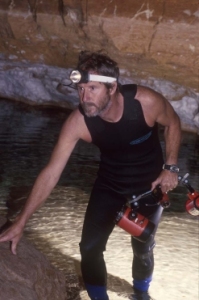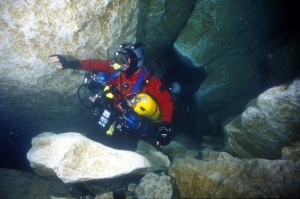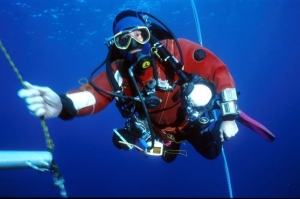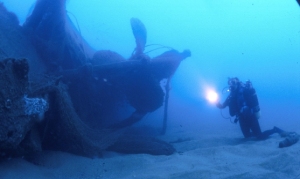The interview that follows was first published in the on-line ‘Nekton Magazine’ in March 2004.
————————
 A true diving adventurer and accomplished underwater photographer whose work is admired and respected around the world, Neil Vincent grew up in the tough, land-locked suburbs of western Sydney.
A true diving adventurer and accomplished underwater photographer whose work is admired and respected around the world, Neil Vincent grew up in the tough, land-locked suburbs of western Sydney.
Inspired (like many of his generation) by the underwater exploits of the fictional character, Mike Nelson, in the legendary television series, “Sea Hunt”, he decided at an early age that he, too, would become a diver when he left school.
As a qualified draftsman employed by a foundation engineering company, Neil worked and travelled all over Australia, the South Pacific and South-East Asia for sixteen years before moving to Norah Head, on the New South Wales Central Coast and into a house built by himself and his wife Lyn. A move that also led to the formation of his own company carrying out 3D CAD design work in the heavy engineering field.
Currently (in 2004 – ed.) involved in helping to design and build a new Outer Suburban train for Sydney, his contract work over the past few years has generally been between twelve to eighteen months, after which he and his equally gifted wife, Lyn, take a three to six month break to go diving and photographing around Australia and overseas.
Always attracted to the unknown and the prospect of seeing places and sights that others might never be privileged to see, Neil Vincent’s outstanding photography has had a profound influence on our better knowledge and understanding of the natural world around and beneath the water’s surface.
——–—-
Q. How did you set about fulfilling those early ambitions to become a diver?
School was a great place to learn about and achieve the things that I wanted. You just had to make the system work for you. In the library I found Ben Cropp’s book with details about how to make a spear gun. While the other kids made coffee tables and pencil boxes in woodworking class, I made a spear gun. My father was horrified and told me that I was not allowed to use it, as I was not a good enough swimmer.
School again came to the rescue with Life Saving and Water Polo as sports. After two seasons of these activities, I thought that I was good enough to go spear fishing, so I did!
School was also where I learned about the basics of photography and where I met my first mentor, a Physical Education teacher who taught many of us the skills of bush walking. But the real lesson that he taught was that of self-sufficiency and the concept of taking responsibility for your own life.
Q. How did you make the transition from spearfishing to diving?.
A car represented freedom and every weekend I travelled along the southern NSW coastline to spear fishing competitions. When it was too rough we surfed. I learnt water sense, the habits of fish and all about boats. On one occasion a person in the Kingfishers Spear fishing club asked me if I wanted to go diving on the following weekend? I said yes, mistakenly believing that they meant spear fishing! When I arrived, I found that they all had scuba tanks. Never having seen scuba equipment before – except on television – let alone used it, I was quickly given a course of instruction: “Breath out of this, when it becomes hard to breath pull this lever and go to the surface no faster than the bubbles you are breathing out”. Certified in this fashion, I dived to 80 feet and loved what I saw. I was hooked and continued to spearfish and to scuba dive.
I joined the South Pacific Divers Club, where I already knew many of the members from the Kingfishers. Among them was a long time friend, Pat Manly. Pat gave me my first opportunity to take a camera underwater.
We were out on his boat, but because the air had leaked from his tank he was unable to dive. I decided to dive alone. Pat offered me his camera and I took it with much enthusiasm. After the dive I gave it back with even more enthusiasm and swore never to take a camera underwater again! On the bottom I couldn’t focus, the fish wouldn’t stay still and the image was upside down, nothing was conducive to taking photos. The three photos that I did take were poorly framed, out of focus and poorly exposed. I couldn’t help but wonder how Pat managed to take his wonderful photos?
Dive shops at the time were rare in Australia, so when we were diving overseas or on the Great Barrier Reef we were required to do everything for ourselves. It was some of the best diving of my life. I brought back great photos of the life topside but nothing underwater so I gave in and bought a Nikonos 4 and flash; the beginning of an expensive and all-consuming habit.
Q. Who are the people that have exercised the greatest influence over
your approach to diving?
Because I learn from experience there are many people who have had an influence over the direction that I have taken with diving and my attitudes towards it. Some of those experiences were not so good, but they nevertheless helped in shaping my approach to diving.
After many years of diving, I eventually did a dive course in order to become a certified diver. Many more years later I decided that becoming an instructor would be a good idea. To that end, I was first required to do an “Advanced Course”; one that I didn’t find challenging unlike some of those around me who were having great difficulty with everything from new gear to air consumption. Having only finished the open water programme the previous weekend, they were certainly too inexperienced to be doing their next course.
On the final weekend of the course a diver who had constantly been running out of air during the programme ran out of air on the 90ft deep dive. He grabbed the regulator from my mouth before rushing us toward the surface, tearing off the mouthpiece in the process. He returned and took my occy, leaving me with the broken regulator! Although we both survived the experience, the instructor still passed this student. I later asked why? His response was that the student had completed all of the dives required in the course and that the shop would want him passed. This incident cured my desire to become an instructor and was my last recreational dive course.
Pat Manly and George Roberts were two very early influences on my underwater photography. Pat led the way in Australia at a time when underwater photographic equipment was primitive and difficult to use. His spear fishing skills allowed him to stalk and capture some of the best fish portraits. He was also very willing to share his knowledge and gave me much help when my first few thousand images didn’t look like his! Shooting large format, George’s images were real life underwater projected onto a screen. I appreciated his images for their sheer photographic artistry.
My first knowledge of cave diving came in a phone call telling me that George Roberts had died in the Mt Gambier cave known as, The Shaft. The lure was set in my mind, I wanted to dive The Shaft. It was another 15 years before an opportunity rekindled that desire.

Pines Cave
I located a CDAA instructor to teach me to cave dive and it was here that I first met Liz and Andrew Wight. With Andrew as our examiner and mentor, Lyn and I both passed our Cat 1 and Cat 2 level exams, learning a great deal of our cave diving basic skills from him along the way.
I had always been self-sufficient in terms of establishing my own goals and then setting out to achieve them. But Liz and Andrew took this to the extreme, accomplishing things that I still only dream about doing. For a period of two years they gave me the opportunity to experience another life, diving, photographing and filming for documentary television; visiting places; meeting people, and experiencing situations that most people only see on television. To again live that lifestyle – but with Lyn beside me – is my dream. So now we work hard, save and then spend months away in remote locations diving and photographing.
While growing up, I had always been in awe of the endurance and achievements of mountain climbers of the era. In the world of diving there are many great achievers, but the one that stands out for me has always been, Sheck Exley. I was fortunate enough to be the organiser for the Sydney leg of Sheck’s CDAA tour. Speaking with him was easy, except that he wanted to talk about what I did as a diver and not what he had accomplished. He was such an experienced cave diver – one with knowledge enough to fill three lifetimes and that he was only too happy to share with others – and yet he would always turn the conversation around to learning about the person with whom he was speaking.
Q. What, for you, is the attraction of Technical diving? What are the essential qualities? And what sort of ‘extreme’ diving has the most personal appeal?
At present, I believe that Technical Diving is sold as a fashion accessory and I don’t consider myself to be a Technical Diver. In that regard, I’m really still doing the same sort of dives that I was doing twenty years ago – the only difference being that I now feel that I’m doing them more safely.
To me diving is a tool. I need certain skills, experience and equipment to go to places that are in a water-filled environment. If I could take a tablet and not require all of the junk required for “technical” dives then I would. (Some of the air fills that I had in the early days would certainly qualify as “mixed gas” diving – and that was at a time when the wreck of the, ‘Birchgrove Park’ was considered extreme. Now it’s a weekend dive from a dive shop!)
 Divers who seek to push themselves beyond the recreational limits should, I believe, possess certain basic skills. These include being physically fit and healthy for diving and being as totally comfortable underwater as they are on land.
Divers who seek to push themselves beyond the recreational limits should, I believe, possess certain basic skills. These include being physically fit and healthy for diving and being as totally comfortable underwater as they are on land.
I never consciously set out to become a Cave Diver. I had a friend who required very clear water to take a particular photo and who decided that Mt Gambier was the best location. As I would be assisting him, I decided that I’d use the opportunity of going to Mt Gambier to dive Piccaninni Ponds. With time to spare before going on the trip, I set about getting the requisite skills and qualifications. Once at Mt Gambier, I still had to complete the prerequisite dives before being allowed to dive Piccaninni Ponds. These certifications mean a lot to me, particularly as these and the Cat 3 exam were difficult and the chance of failure very high.
I am not at the forefront of “technical” diving – or even close – although I do watch those who are. I don’t want the glory of being the first. There are others who are much more skilled and who have all of the characteristics of real explorers. Most of them are fairly quiet people driven by the desire to explore the technical and physical extremes of diving rather than for the sake of any accompanying fame.
I enjoy being the next in line, where I can use what they have taught me to get to where they are and record on film what they have achieved or discovered. I enjoy being the first with a camera, photographing subjects that cannot be dived by everyone, or photographing them in such a way that it shows some new aspect or perspective.
I enjoy diving anything that is new or different – especially if it can be photographed.
Q. What is your personal view of technical diving? The agencies involved?
It’s advantages – at the personal level – and its future?
This question will get me into trouble!
“Technical Diving” was a derogatory term used by the mainstream diver training agencies to label those “radical” divers who dared to dive outside of the recreational depth limits, and who used Nitrox and other mixed gasses.
Once those agencies realised that there was a growing market for this type of diving they not only accepted the techniques and practices that they had previously condemned, but also introduced their own “technical training” programmes.
The problem that I have with this is that many instructors are just teachers. All too often they do not do much diving outside of their teaching role. And while they are good at teaching theory and training people in the basic skills they sometimes lack the necessary real world diving experience.
The term “technical diver”, or “tekky” – and the equipment that accompanies the image – captivates many would-be students. I believe that they are encouraged to move too quickly through the programmes and to purchase the necessary gear in order to look the part. But they seldom gain enough experience between the courses.
Those divers with the real spirit of adventure are the ones who will continue in the activity. They tend to be the same people who would have succeeded without the training agencies, as divers have in the past. They learn by selective training, research, getting out and diving, finding their own way and making use of the information available as they advance.
The training agencies will continue along their own path. They are honed big businesses whose main goal is to make a profit through teaching diving. In today’s society the main aim of companies is not to produce a product, employ people and pay their wages, it is to produce a dividend for the shareholders. It’s sad really.
Q. As an accomplished U/W photographer, what particular aspects of the U/W
environment appeal to you the most? And Why? How do you view the role of
the U/W photographer? (i.e. Are they a participant or just an observer?)
I enjoy looking through the viewfinder and seeing the image before me, framing it, lighting it, and trying to create on the film what I imagine I see. Whether it’s looking at the highly magnified face of a small fish through a macro lens and seeing the extreme detail of the colours in it’s eye, or setting up for a long time exposure painting strobe flashes in the back of a water filled cave – or something in between those two extremes – I treat each image as a technical challenge. I know how I want the image to look, I have the equipment and I am the one who has to make it happen, the camera won’t, nor will the strobes or the model, it is me controlling all of these factors.
Each person who takes photos underwater does so for their own reasons. For most, enjoyment must be the main driving force. It still is for me. Even selling photos doesn’t spoil the fun it just helps to pay for all the film! When photographing natural history subjects, I enjoy long dives where I have time to study the subjects before trying to photograph them in unique or unusual situations.
Cave diving photos tend to be more technical and pre planned, but again there is usually a fair amount of time to execute the shot, or to go back and try it again. Getting equipment to the dive is quite often a technical feat all by itself. Camera equipment is neither light in weight nor built to withstand rough treatment, so winning friends among the other people portaging equipment to the dive site is often difficult. I was once asked at the end of a dive in a difficult Nullarbor cave if the equipment was insured? When I replied that it was, it was suggested that I should just leave it there!!!
Wrecks tend to be deep, so bottom time is limited. Lighting large areas of the vessel is a challenge and as well as attending to all of the technical aspects of the dive a lot of pre-planning is put into the photo side of a wreck dive.
In cave and wreck diving photography, I feel as though I’m more than just a participant, I feel that I am controlling the photos in much the same way that a studio photographer does. Natural history is a different scenario. Here I am only the observer – and sometimes the observed. The creatures of the underwater world do as they please, I have no control other than trying to pre-empt what they will do. It is only previous experience that assists here.
Q. What have been your most memorable dives?
With a broad range of diving experiences gained from seeking out new places and creatures, I have many memorable dives.

The Birchgrove Park
Diving the, ‘Keilawarra’, on the NSW north coast will stay with me for a long time. Much to the disgust of my dive buddy, John Reilly, the ‘Keilawarra’ is covered in beautiful sponges, soft corals and sea whips and has become a beautiful reef ecosystem. Beneath this colour was the wreckage of a past era slowly being consumed by the elements – twisted steel, rusted conglomerations of chain, masses of heavy metal in anchors, and engines. Seemingly unaffected by their years underwater there were brass and glass port holes, china plates, cups, leather boots all spread across the seafloor where they remain, unseen by all but a few and left untouched for others to see.
Blackjack, the B17 Bomber lying on the sand 100 feet below, is always a grand sight when first seen through the Sea Whips of the reef. It is as though it has been parked there and forgotten. There is some growth on it – but not that much. Its beauty is in its shapes. They are out of context with the environment but still suit the fish “flying” about it.
From my second dive in McCavity cave I knew that I would be drawn back to it’s beautiful formations. (The first dive was a disaster!) The entry, a tight inhospitable solution tube, is not a thing of beauty! But it is the guardian to the cave, and once passed where else in Australia can you move through such a decorated cave in clear water. The decorations are from a time when the cave was dry and the formations were alive. When the water level drops many of these formations come back to life, the tiny Helictites drip water as they grow in their torturous form, air pockets reflect giant stalactites in mercury-like mirrors, while smaller stalactites and stalagmites form Dragon’s Teeth.
For the first time last year I was able to dive Tank Cave in Mount Gambier. Found in the late 1980’s it has grown from a muddy puddle into 7000 plus metres of maze-like passageways. It was a stimulating dive, one in which each area presented different colours, passage structures and rock textures offering wonderful new photographic opportunities. And because it was new to me, I was exploring.
As you can see, my favourite dives are about the beauty of what I see, not the equipment that gets me there.
My favourite creature dive must be in northern Bali, at Tulamben, a narrow reef and sand flat perched on the side of a 2000 metre plus abyss fed by strong up welling currents full of nutrient. This is a natural history observer/photographer’s paradise with strange fish from tiny Garden Eels to 1000 kg Mola Mola. I have been there twice and never tire of the diving. The first trip was for four weeks and the second for six weeks duration and on each trip we averaged four dives a day with very few days off.
The diving is all from the shore and allows repeat visits to photograph suitable subjects. Usually I came out of the water because I had run out of film, not because of a lack of air or subjects to photograph.
Q. What drives you to attempt some of the dives that you do?
Quite simply, a goal! I equate goals with enjoying and challenging myself.
I have difficulty watching television because I feel I am wasting time. On a sunny day (except for work) I cannot bring myself to use a computer to play with Photoshop because I feel guilty about not being outside and achieving something – even if it’s mowing the lawn. But on a rainy day I feel fine. I’m sure that I drive Lyn and my friends mad but this same approach flows into my attitude towards my diving.
Because I have been diving for many years any dive without a goal – as, for example, diving to a sand bottom at any depth merely to look at my depth gauge and say to myself, or others, “I have been there” – has no appeal.
However, to swim around a sandy bottom with a camera in my hand and even the sketchiest information that there is a photographable subject in the area is very satisfying. The camera makes a huge difference to my enjoyment of a dive. This is me I am talking about! I know and recognise that others have different – and even opposite – feelings about diving with a camera and I understand and greatly respect their views.
I enjoy being part of a group or team with a specific goal and being able to contribute my skills to those of the others to achieve an outcome. I gain enjoyment from the dives that I make, from photography and from being with other like-minded divers.
Q. Apart from the mechanics of diving, do you have a personal philosophy
or view of the activity?
I look at life through practical eyes and don’t really philosophise – something that I again consider to be a waste of time. When I have forced free time to think – as during the 40 minutes drive to work by myself each day – I tend to daydream about practical things, like how to rig gear for a dive, make better strobe arms, or set up a particular photograph. Rarely to I philosophise about Life, the Universe or Anything, because I can’t change it. I am just too small.
The world does need changing – mankind’s treatment of the oceans is a particular case in point – but when I see people who have real authority and power achieving nothing, I quietly go about my own life doing what I believe is good for those around me and the environment. I know that I have changed nothing, but equally I have tried to cause nothing harm.
Q. What type of diving gives you the most personal pleasure and
satisfaction?
Any dive where I find interesting subjects to photograph. Satisfaction comes when I get the film processed and I see quality images.
—ENDS—
Categories: Profiles
Canât wait to read! Thanks!!
>
LikeLike